FALL SPLENDOR
A charming autumn display decorates the back porch of the Dr. Daniel W. Kissam House Museum during the Huntington Historical Society’s annual Apple Festival on Oct. 14. Photo by Heidi Sutton
FALL SPLENDOR
A charming autumn display decorates the back porch of the Dr. Daniel W. Kissam House Museum during the Huntington Historical Society’s annual Apple Festival on Oct. 14. Photo by Heidi Sutton
Love is in the air, which can cause troubles on the roads.
It’s deer rutting season — the time of year they breed — which means the animals are prone to run out on local roadways, causing potential dangers for drivers. While it’s advisable to drive carefully and be vigilant at any time of day, especially near wooded areas, peak time for rutting occurs between dusk and dawn requiring extra caution during those hours, according to the New York State Department of Environmental Conservation.
Lori Ketcham, a rehabilitator with Middle Island-based Save the Animals Rescue Foundation, said the rutting season begins approximately in the middle of October and lasts until the end of November, sometimes longer. She said her main advice during the season is for motorists to drive carefully because the deer don’t think.
“The boys only have one thing on their mind,” Ketcham said. “They’re following the scent so they’re just running. They smell a girl down the street. They run, and they don’t care if there are roads in the way.”
She said if two bucks are fighting, something that would most likely happen in wooded areas and not near the road, to steer clear of them. She said it’s important when seeing a deer run across the street to remember there is a chance another one will follow, whether it’s a buck in heat or a fawn following its mother.
“They are a herd animal,” she said. “If one runs across the road, assume there are more coming.”
Ketcham said it’s important for drivers to keep their eyes not only on the road but the sides of the streets. She said sometimes deer are not hit by a car but run into the side of it, breaking their jaws or necks.
The rehabilitator said it’s important for drivers who hit a deer to check to see if they are dead or not, and not to approach or move an injured deer. Whenever a motorist hits an animal, even smaller ones like squirrels and raccoons, Ketcham advises people to call the police department, adding a person won’t get in trouble for hitting an animal with a car.
“Have someone come out and not have the animal out there suffering,” she said.
Drivers are also cautioned to slow down when approaching deer near a roadside, according to the DEC. While they may look inactive, they can quickly bolt in front of a car.
By Teresa Dybvig
We almost missed the stunning sight — hundreds of monarch butterflies in one place at our very own West Meadow Beach, or to be more precise, the West Meadow Wetlands Reserve.
If you have walked along the beach recently, you’ve probably noticed the field of seaside goldenrod (Solidago sempervirens) lighting up the edge of the dunes all the way down the beach.
On Thursday, Oct. 4, my husband and I happened to turn away from the water to gaze at the goldenrod glowing in the late daylight. As we approached, we saw hundreds — probably thousands — of buzzing bees and wasps on the flowers. Then we saw a flash of orange, then another, and another. To our astonishment, everywhere we looked, we could see up to 10 monarch butterflies without turning our heads!
We returned on Sunday with a camera and more time. Walking steadily down about a third of the beach, we counted 144 monarchs! I’m sure there were many more; the field is so deep we couldn’t see every flower, and when monarchs fold their wings to eat, they are as thin as a blade of grass from the front. And we didn’t even get to two-thirds of the field. I’m not exaggerating when I say there were, literally, hundreds of monarchs on the beach that day.
If you have ever seen a monarch butterfly, you know it is gorgeous. It also has a jaw-dropping multigenerational migratory life cycle. The monarchs feasting on the goldenrods at West Meadow are fueling up to fly 2,700 miles to Mexico, at an average rate of 25 to 30 miles per day. Some have already traveled great distances to get here.
This generation of monarchs is sometimes called the “supermonarch” because it’s the only generation strong enough to make the trip, overwinter on a cool, damp Mexican mountaintop, and fly north again to lay eggs in the earliest-growing milkweed in the southern U.S. before its life comes to an end. The eggs laid by the supermonarchs will grow into monarchs who will fly north and repeat the process, living only two to five weeks.
The next supermonarchs are the offspring of the offspring of the previous generation of supermonarchs. Sometimes they are the offspring of the offspring of the offspring. So no monarch flying to Mexico has ever made the trip before. Yet thousands of generations have made the journey.
Our eastern monarch butterfly, Danaus plexippus is in a heartbreakingly steep and dangerous decline. For every 10 monarchs in the sky two decades ago, there are now only two. Researchers estimate that this species could be extinct within 20 years. If the monarch ceases to exist, we humans will have been the cause.
Monarchs are in danger because of human activities. We have cut down the trees monarchs require to overwinter in Mexico, we have killed milkweed that is critical for monarch caterpillars by spraying fields and their peripheries with herbicides like Round-up, we have paved over land where monarchs used to fuel up on nectar for their spectacular fall migration to Mexico, and we have contributed to changes in weather that can render the monarch’s route dangerous.
But we humans have also been working to help the monarch stay in the skies. People in Mexico are growing trees to replace the ones that were cut. Government agencies and ordinary citizens in the U.S. and Canada are planting milkweed in reserves and home gardens. And we are planting more fall-blooming native plants to fuel the long migration to Mexico.
This is where West Meadow Wetlands Reserve comes in! The seaside goldenrod there is one of the primary foods for monarchs migrating south. The wildflower’s blooming season is relatively short, so if you want to see the miracle in action, keep a lookout next fall in late September and early October.
Walk past the left end of the swimming area until you see the shining field of yellow flowers. Stand facing it for about a minute, and you will see a flash of orange, then another, and another. “We did this,” you can say to yourself. Our community. We set aside land for these flowers to grow, and they are helping these amazing creatures stay in the sky.
The author is a resident of Stony Brook.
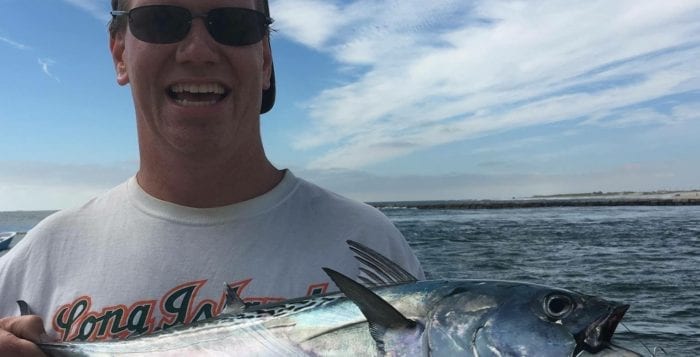
By Daniel Dunaief
In August of 2014, Islip experienced record rainfall, with over 13 inches coming down in a 24-hour stretch — more than the typical rainfall for an entire summer and a single day record for New York state. The rain required emergency rescues for motorists whose cars suddenly died after more than 5 inches of rain fell in a single hour.
What if, however, that rain had fallen just 50 miles west, in Manhattan, where the population density is much higher and where people travel to and from work on subways that can become flooded from storms that carry less precipitation?

Brian Colle, professor of atmospheric sciences and director of the Institute for Terrestrial and Planetary Atmospheres at the School of Marine and Atmospheric Sciences at Stony Brook University, is part of a group that is studying flood risks in the New York metro area during extreme storms that could bring heavy rains, storm surge or both. The team is exploring mitigation strategies that may help reduce flooding.
“The risk for an Islip event for somewhere in the NYC-Long Island area may be about one in 100 years (but this is being further quantified in this project), and this event illustrates that it is not a matter of whether it will occur in NYC, but a matter of when,” Colle explained in a recent interview.
The group, which is led by Brooklyn College, received $1.8 million in funding from New York City’s Department of Environmental Protection and the Mayor’s Office of Recovery & Resiliency. It also includes experts from The New School, the Stevens Institute of Technology and Colorado State University.
The co-principal investigators are Assistant Professor Brianne Smith and Professor Jennifer Cherrier, who are in the Department of Earth and Environmental Sciences at Brooklyn College–CUNY.
Smith, who had worked with Colle in the past, had recruited him to join this effort. They had “been wanting to do studies of flooding for New York City for a long time,” Smith said. “When the city came out with this” funding for research, Colle was “the first person I thought of.”
Malcolm Bowman, a distinguished service professor at Stony Brook University, holds his colleague, whom he has known for a dozen years, in high regard. Colle is “a leading meteorologist on regional weather patterns,” he wrote in an email.
Colle is interested in the atmospheric processes that produce rainfall of 2 or 3 inches per hour. “It takes a unique part of the atmosphere to do that,” he said. The three main ingredients are lots of moisture, lift along a wind boundary, and an unstable atmosphere that allows air parcels, or a volume of air, to rise, condense and produce precipitation.
Representatives from the local airports, the subway systems and response units have been eager to get these predictions, so they can prepare mitigation efforts.

This group has taken an ambitious approach to understanding and predicting the course of future storms. Typically, scientists analyze storms using 100- to 200-kilometer grid spacing. In extreme rainfall events during coastal storms, scientists and city planners, however, need regional spacing of 20 kilometers. Looking at storms in finer detail may offer a more realistic assessment of local precipitation.
Researchers are anticipating more heavy rainfall events, akin to the one that recently caused flooding in Port Jefferson.
A warmer climate will create conditions for more heavy rains. Water vapor increases about 6 to 7 percent for every degree increase in Celsius. If the climate rises two to four degrees as expected by the end of the century, this would increase water vapor by 13 to 25 percent, Colle said.
The group includes experts from several disciplines. “Each of the scientists is highly aware of how integrative the research is,” Cherrier said. The researchers are asking, “How can we provide the best scientific foundation for the decisions” officials need to make. If, as predicted, the storms become more severe, there will be some “hard decisions to make.”
Smith suggested that a visible project led by women can encourage the next generation of students. Women undergraduates can appreciate the opportunity their female professors have to lead “cool projects,” she said.
Raised from the time he was 4 in Ohio, Colle said he was a “typical weather geek” during his childhood. The blizzard of 1978 fascinated him. After moving to Long Island in 1999, Colle used to sit in a weather shed and collect ice crystals during nor’easters. He would study how the shape of these crystals changed during storms. An avid surf fisherman, Colle said there is “not a better place to observe weather” than standing near the water and fishing for striped bass, fluke, bluefish and false albacore. A resident of Mount Sinai, Colle lives with his wife Jennifer, their 16-year-old son Justin and their 13-year-old son Andrew.
As for his work on flood risks around the New York metro area, Colle said the group is producing monthly reports. The effort will end in December. “The urgency is definitely there,” he acknowledged. Heavy rainfall has increased the need to understand rain, particularly when combined with surge flooding.
A transportation study written over a decade ago describes storm surge and rainfall risk. That study, however, included a prediction of 1 to 2 inches of rainfall an hour, which is far less than the 5 inches an hour that hit Long Island in 2014.
“Once you start seeing that, there’s a lot of people who are nervous about that risk and want to get a best estimate of what could happen,” Colle said.
Cherrier described New York City as being “quite progressive” in gathering information and formulating data. “The city wants to be prepared as soon as possible.”
AUTUMN COLORS
No doubt Tom Caruso of Smithtown was struck by the gorgeous color of these mums before he snapped this photo at a farm stand in East Setauket.
Send your Photo of the Week to [email protected].
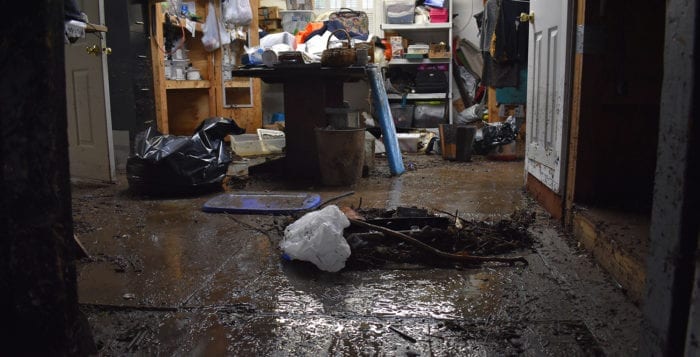
Though the floodwaters have receded a week later, cleanup and questions still remain.
Port Jefferson Village was hit with more than four inches of rain in about an hour during the evening Sept. 25, and while village trustee Bruce D’Abramo joked Port Jeff might have been prepared to handle a 100-year storm, it wasn’t ready for the “200-year storm” it sustained. The extreme rate of rainfall resulted in flash flooding that inundated Main Street, trapped motorists in cars, washed out those dining out in restaurants and soaked auditioning actors at Theatre Three. The theater and other businesses like Ruvo East on Wynn Lane and Old Fields of Port Jefferson a block over experienced high water marks of about four feet. Old Fields was closed for a few days after the storm while Ruvo remained closed for renovations due to the flooding as of Oct. 2. Port Jefferson School District’s two instructional buildings also were affected by the flooding, according to its website, and officials are in the process of determining what aspects of the damage are covered by insurance.
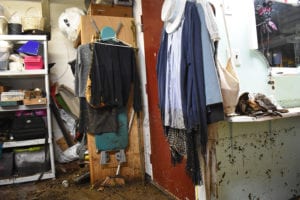
A furious volunteer effort ensued to get Theatre Three up and running in time for its Sept. 28 productions.
“We managed to get everything ready for Friday night and ran the entire weekend,” said Jeffrey Sanzel the theater’s executive artistic director.
Bradlee Bing, who serves on Theatre Three’s board of directors and was one of its founding directors in 1973, said cleanup efforts were undertaken by dozens of volunteers and staff in the 72 hours between the storm and Friday night’s productions. Work was done around the clock, spearheaded in large part by Brian Hoerger, the theater’s facilities manager, who Bing called the “champion” of the cleanup effort for his organizational and leadership role.
“As dark a day as it was, the sunshine and light of the volunteers really rejuvenated our energies and enthusiasm for what we’ve [been] doing these past 50 years,” Bing said. “The number of people that came down, multiple dozens of people that committed their time to putting everything back in order. The support of the town and community was overwhelming.”
He said restaurants donated food to help keep volunteers going, and The Home Depot and Lowe’s donated supplies to help remove the tons of mud and other remnants of the flood. He said much of the theater’s electrical wiring was destroyed. Sanzel said some other important items sustained major damage, including an HVAC unit, the boiler, costumes, a large chunk of props used in annual productions of “A Christmas Carol,” all of the props from the touring show “From the Fires: Voices of the Holocaust,” along with “many, many other things.”
“We’ve experienced in the past certain types of flooding in Port Jefferson,” Bing said. “This last one was the worst flooding event we’ve ever experienced. Wednesday morning was a mud disaster in the theater.”
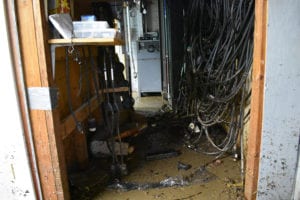
New York State Assemblyman Steve Englebright (D-Setauket) indicated he’s seen severe flooding in Port Jeff in the past during nonhurricane weather events, but this particular storm raised his eyebrows for a number of reasons. The storm occurred during low tide and flooding was not due to tidal waters, meaning had it occurred during high tide it’s possible tidal floodwaters would have combined with the flash flooding to cause water levels to reach in the ballpark of 10 feet instead of the four to five feet that actually occurred, Englebright said.
“When you put a layer of sand on top of a living marsh and then build housing and buildings on it, and rename it from Drowned Meadow to Port Jefferson, and hope nobody would notice, nature will come back and bite you from time to time,” he said. As the chairman of the Assembly’s Committee on Environmental Conservation, Englebright indicated storms like this one could become more frequent. “That’s a kind of a preview of what’s going to happen if we don’t seriously address climate. The big flood is still in the future, but the signposts all point toward continuing sea level rise. So I’m concerned.”
Englebright suggested in the meantime serious consideration be given to raising future structures constructed in the village above ground level.
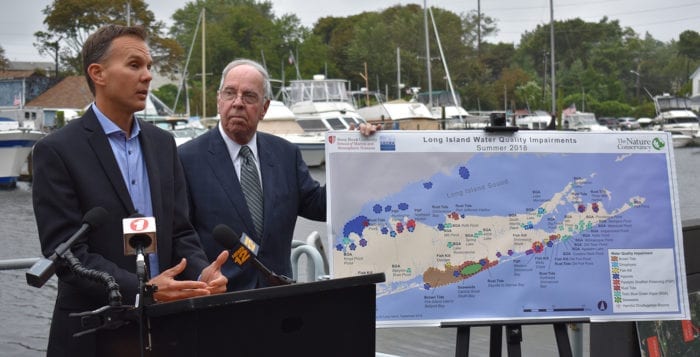
Long Island’s water is facing a dangerous threat — not a mythical sea monster, but harmful and poisonous algal blooms. Recently released data showed the problem was more far reaching this summer than years past.
The Long Island Clean Water Partnership, an advocacy collective supported by the Rauch Foundation, that includes members from Stony Brook University and the Long Island Pine Barrens Society headed by Dick Amper, released an annual water status report Sept. 25 that showed new harmful algal blooms in Port Jefferson, Northport and Huntington harbors and in North Shore ponds and lakes.
“Every single water body across Long Island, be it the North Shore or the South Shore, East End, Suffolk County, Nassau County, all had significant water impairments during this time frame,” said Christopher Gobler, endowed chair of Coastal Ecology and Conservation at the Stony Brook University School of Marine and Atmospheric Sciences. “We would call this a crisis.”
“We are the nitrogen pollution capital of America.”
— Kevin McDonald
The Island-wide study, which was conducted from May through September, showed Northport Harbor suffered a bloom of Dinophysis, a type of algae that releases a powerful neurotoxin that can affect shellfish. Both Northport and Huntington harbors showed a rash of paralytic shellfish poisoning in other marine life from eating shellfish.
In May, shellfish fishing was temporarily banned in Huntington and Northport harbors by the New York State Department of Environmental Conservation because of PSP. The harmful poison began to wane in June, Gobler said, and those bans have since been lifted, according to an automatic message put out by the state DEC.
Stony Brook University’s Roth Pond has been experiencing for years summer blooms of poisonous blue-green algae, a type that is harmful to animals. This past summer the researchers saw the algae spread into neighboring Mill Pond in Stony Brook. In 2017, Suffolk County had more lakes with blue-green algal blooms than any other of the 64 counties in New York, according to the report.
The summer also saw the rise of a rust tide in Port Jeff Harbor and Conscience Bay caused by another poisonous algae, which, while not dangerous to humans, is dangerous to marine life. Gobler said while it did not necessarily lead to fish kills along the North Shore, places like Southampton saw the deaths of tens of thousands of oysters and fish due to rust tide. If the problem persists, Port Jeff might start to see a fish die-off, which could have lasting implications to the local ecology.
The algal blooms and hypoxia were both exacerbated by a particularly warm summer, a trend expected to continue due to climate change. In coming years, Gobler said he expects the number of dangerous algae to spread because of this trend.
“We’re expecting that temperatures will rise 5 or 10 degrees this century, so we need to make changes or things will get significantly worse,” Gobler said.
The prognosis looks grim, with multiple other places across Long Island experiencing harmful algal blooms, but the source is already well known. This year’s study cites heavy loads of nitrogen pollution from sewage and fertilizers as the ultimate source of the algal events, particularly the nitrogen waste from old cesspool systems leaking into local waters.
Suffolk County and several state and local politicians have been advocating for changes, either for creating sewer systems — such as Smithtown’s projects in Kings Park, Smithtown Main Street and St. James — or by creating financing programs for property owners to overhaul waste systems.
In 2014 Suffolk County Executive Steve Bellone (D) called nitrogen pollution the county’s “environmental public enemy No. 1.” Since then the county has worked with local scientists and engineers to craft technology that could replace Long Island’s old cesspool and septic tanks, but some of those replacement systems have been very cost prohibitive. Suffolk has made some grant money available to those interested in upgrading.
New York Gov. Andrew Cuomo (D) signed legislation in April that put $2.5 billion toward clean water protection and improving water infrastructure, including $40 million for the new sewer systems in Smithtown and Kings Park, and adding a rebate program for those upgrading outdated septic systems. Suffolk County and scientists from Stony Brook University are currently working on cheaper nitrogen filtration systems, but commercial availability of those systems could be years away.
“Technology and governmental policies are rapidly changing to address our island’s water crisis, but we need to increase our pace of change.”
— Adrienne Esposito
Kevin McDonald, the conservation project director at The Nature Conservancy, said that there is a strong impetus for all of Long Island to change its waste standards.
“We are the nitrogen pollution capital of America,” McDonald said. “We can’t reverse climate change by ourselves, but with the right support and engagement and leadership we can aggressively respond to this problem at a faster pace than at present.”
Many of these areas now experiencing algal blooms were only encountering hypoxia, or a depletion of dissolved oxygen in water necessary for sea life to survive, in the same report released back in summer 2017. Last year Mount Sinai Harbor was spared from severe hypoxia, but now has seen a decrease in necessary oxygen levels this past summer. Gobler said it wouldn’t be out of the question that Mount Sinai Harbor could experience a potentially dangerous algal bloom next summer.
One thing is for sure, according to Gobler: Long Island will experience more hypoxia and harmful algal blooms until new waste systems can catch up to the amount of nitrogen that’s already in the water.
“Technology and governmental policies are rapidly changing to address our island’s water crisis, but we need to increase our pace of change,” said Adrienne Esposito, the executive director of the environmental advocacy group Citizens Campaign for the Environment.
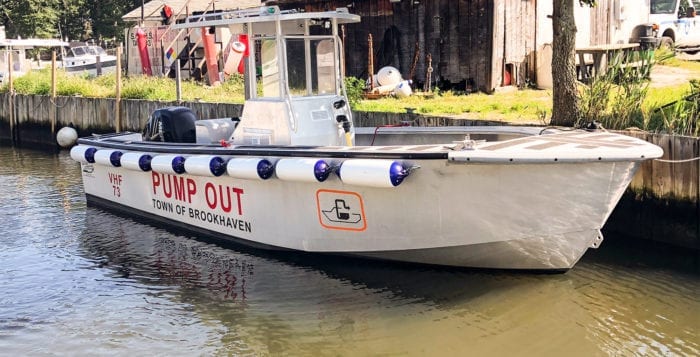
If you’ve ever seen a boat with a built-in toilet, the next question is inevitable: Where does that waste inevitably go?
Either the waste goes straight into the Long Island Sound or surrounding harbors or boaters call the Town of Brookhaven’s pump-out boats, a service provided by the town for free, to suck out the waste, according to Karl Guyer, a senior bay constable for Brookhaven.
At Brookhaven town’s Sept. 13 meeting the board voted unanimously to purchase two new pump-out boats — one for Mount Sinai Harbor and one for Port Jefferson Harbor. The total cost for both boats is $92,500 with $60,000 of that amount coming from state aid in grant funding from the New York State Environmental Facilities Corporation. The town is supplying $32,500 in matching funds from serial bonds, according to town Councilwoman Jane Bonner (C-Rocky Point).
The town operates four pump-out boats, including two on the South Shore and two on the North Shore, which are located in Port Jeff and Mount Sinai harbors. All these boats were purchased in 2006, and Guyer said it was time all of them were replaced. The two on the South Shore were replaced this year, and the North Shore boats will be replaced early in 2019, according to Guyer.
“They’ve been in service for quite a number of years and they’re at the end of their life span,” Guyer said.
The pump-out boat in Port Jeff Harbor is showing signs of long use. The paint on the boat’s deck has been worn down by years of work, and there are cracks showing in some of the plastic hatches around the boat. William Demorest, the bay constable for Port Jeff Harbor, said the new boats will be made from aluminum, which should give them a longer life span.
The pump-out boat service is widely used by the boaters in both harbors, and on a busy day town employees operating the boats can service hundreds of boats in a single day. People can call for a pump out by radioing the constable’s office on channel 73.
There is a manual boat waste pump in a barge inside Port Jeff Harbor, though the constable said 75 percent of the over 700 boats that come to port on summer weekends use the pump-out boat service. After the pump-out boats are docked for the winter, all North Shore boaters are required to manually pump out their own waste.
Bonner said these boats do a major service in cleaning out the tanks of many boaters, because dumping the waste into the coastal waters only adds to the islands growing water pollution problem.
“Not only would there be waste in the water but the nitrogen load would be crazy,” Bonner said. “It would take several tides to flush that out.”
All the water from Conscience Bay through Port Jefferson Harbor as well as the entire Long Island Sound is within mandated U.S. Environmental Protection Agency No-Discharge Zones, meaning it is illegal to dump any boat waste into the surrounding waters.
While Demorest said he hasn’t seen people dumping their waste into the water himself, he has heard reports of it being done. He said he believed the vast majority use the free pump-out service.
“If we don’t see it, there’s nothing we can do about it,” he said.
Many areas of the North Shore are experiencing waves of hypoxia, an increase of nitrogen in the water that deprives sea life, both plants and animals, of oxygen. During a press conference Sept. 25, co-director of the Center for Clean Water Technology Christopher Gobler and other researchers from the Long Island Clean Water Partnership concluded there were cases of harmful algae blooms in harbors from Mount Sinai all the way to Huntington, another symptom of excess nitrogen in the water. Most of that nitrogen has come from cesspools and septic tanks from people’s homes slowly leaking into the surrounding waters.
The boats usually operate Friday, Saturday and Sunday mostly by high school and college-aged summer employees, according to Guyer. The pump-out boat service ends on Columbus Day, Oct. 8.
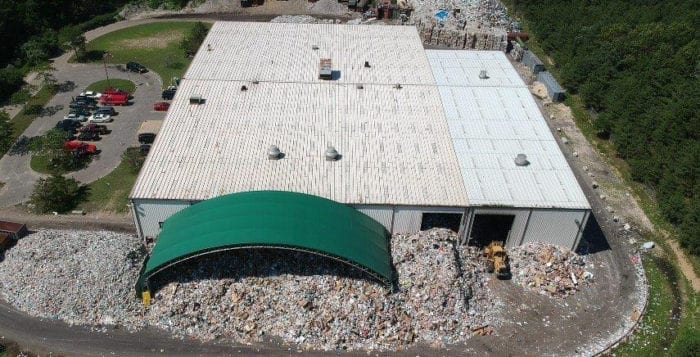
It’s a rubbish time to be involved in the recycling industry.
The Town of Brookhaven’s recycling plant is grappling with unprecedented mounds of bottles, used paper goods and trash. Ever since China implemented its “National Sword” policy in January banning the import of various nonindustrial plastics, paper and other solid wastes, Brookhaven’s had a hard time selling off collected recyclable materials. As China was one of the top buyers of U.S. recyclables according to NPR, this move has left many Suffolk townships unsure what to do with their residents’ recycled garbage.
To recycle or not: Tips on handling your trash
By Kyle Barr
Operators of the Brookhaven recycling plant deal with a lot of junk. Not the good kind of junk, however, as many household items that residents assume can be recycled can cause havoc in the machinery.
In the four years since the town invested in single-stream recycling, Erich Weltsek, a recycling coordination aid for Brookhaven, said there has been increased resident participation in the recycling program. But it has also led to some residents chucking in items that have no business being recycled.
“We’ve gotten chunks of concrete, and you even get sports balls — like soccer balls, footballs — constantly,” he said. “A lot of what we call ‘wish cycling,’ where people think they’re doing the right thing and when in doubt they throw it in a recycle bin instead of the right receptacle.”
Weltsek said people have tried to recycle Coleman outdoor stoves and propane tanks, which is extremely dangerous and could result in an explosion at the facility.
The most pervasively disruptive items are plastic bags and other items that Weltsek called “tanglers,” such as Christmas tree lights, pool liners and garden hoses. The recycling facility operates on a number of conveyor belts that first feed into a device called a star screen, a number of rotating cylinders with feet that separate recyclable fibers from other items. These items either wrap around the wheels on the conveyor belt or star screen, either letting fibers through the wrong end or stopping the machine entirely.
Suffolk residents should clean out any plastic bottles or cans before putting them in the recycling. Any low-quality paper products or grease-stained cardboard such as used pizza boxes, should not be recycled because they affect the sellable quality of the entire recycling bundle.
Andrade said all plastic bags should be recycled at a local supermarket, which are mandated by New York State law to have a receptacle for all shopping bags.
The plant often has to turn away other nonrecyclable material, such as plastic utensils, bottle caps and Styrofoam. All of these are considered contaminants, either because they cannot be recycled properly, or they
dilute the quality of the material.
“While it hasn’t stopped it, China’s new policies have significantly slowed down the ability of recyclers to move material to market,” said Christopher Andrade, commissioner of Brookhaven Town’s waste management department. “There are domestic mills and domestic markets [but] the thing is just finding them, negotiating them and moving the material.”
That is easier said than done, according to Andrade, as many recycling plants across the nation now have fewer options of where to sell their collected goods. China has publicly claimed the decision has to do with the quality of the materials, as low-quality newspaper print or thin PVC plastics are not considered valuable enough for reuse. There’s also the problem of recyclables being mixed with other, nonreusable garbage.
In 2014, Brookhaven moved from dual-stream to single-stream recycling, a system that allows residents to put out all their recyclables in a single can to be sorted out at the town’s facilities instead of bringing out a different material — plastic, papers or metal — every other week. This increased overall participation in the recycling program, Andrade said, but has led to some confusion.
The loss of the Chinese market has severely interrupted the Brookhaven-owned Green Stream Recycling facility’s outflow. Green Stream Recycling LLC, a company that contracts with the town and operates the town’s facility in Yaphank, made good use of China’s market. While the facility continues to operate without a definitive answer to where else the company can move its materials, some of it is now going back into the landfill, according to Andrade.
This crisis is not only affecting the Town of Brookhaven, but other municipalities on Long Island which sell their collected recyclables to Suffolk County’s largest township. In 2014, the Town of Smithtown formed a five-year contract with Brookhaven to send 12,000 tons of garbage to the Green Stream facility, in return for $180,000 per year. While Brookhaven continues to honor the agreements with its partnered municipalities, the lack of market availability for recyclables has some members of Smithtown Town Board concerned.
At a Sept. 4 work session, Smithtown Supervisor Ed Wehrheim (R) showed board members a photo taken by a drone in May showing recyclables piled in heaps just outside Brookhaven’s facility. The picture made Wehrheim and other board members question what might become of the town’s current recycling agreement.
“At one point, we’re going to come to some decision what to do with [Brookhaven Town,] Wehrheim said. “It could be a potential problem … in the short term.”
Andrade said that excess dumping on the facility’s land came from the “shock” of China’s National Sword policy being implemented earlier this year, though he said the situation has since been brought under control. Despite these international issues, Andrade said Brookhaven remains committed to recycling.
Brookhaven Town Supervisor Ed Romaine (R) “and the board believe very strongly in recycling, and we’ll bounce back from this,” he said.
“The markets are being overwhelmed; the people taking the material can be picky on what they accept. We’re going to have to respond by being better at only putting out the things that people can actually reuse.”
— Russell Barnett
Russell Barnett, Smithtown’s environmental protection director in the Department of Environment and Waterways, said he is working on a solution with Brookhaven, including a regional approach comprising Smithtown, Huntington, Southold and several other communities that are partnered with Brookhaven.
Smithtown had its own dual-stream facility that was closed before it started sending its materials to Brookhaven in 2014, though reopening it could be costly.
“We’re assessing our equipment — seeing what’s operational, what’s not, what repairs need to be made and what upgrades need to be made if the occasion comes up that we want to go that route,” Barnett said.
In the meantime, he said residents need to be more discriminating when it comes to deciding what items to recycle. Otherwise, it will be much harder in the future to find a buyer for the world’s recyclable garbage.
“When they talk about the standard, they’re not just talking about nonrecyclable material
but the right kind of recyclable material.” Barnett said. “The markets are being overwhelmed; the people taking the material can be picky on what they accept. We’re going to have to respond by being better at only putting out the things that people can actually reuse.”
By Elof Axel Carlson

Biologists classify living things using a system that Carl Linnaeus (1707–1778) introduced in the 18th century and that has grown in detail over the decades as new forms of life are found and studied. Humans are familiar with being vertebrates (a class of the phylum Chordata). Chordates are animals with a spinal cord, spine or an embryonic structure called a notochord. There are 55,000 chordate species. So far there are 109 phyla covering plants, animals, protozoa, fungi, bacteria and archaea, which are less precisely organized into kingdoms and domains.
One phylum, first discovered in 1883, consisted of just one species until recently. These are the Placozoa (placo = flat and zoa = animal). They are small (about an eighth of an inch or 1 mm) and are roughly disc shaped with three layers. The top layer has cells with a hairlike thread called a cilium. The bottom layer is also ciliated but has additional cells that take in food from the ocean muck on which the placozoa live. The middle layer has amebalike cells and fiber-bearing cells that contract, making the placozoa lumpy in appearance.
They reproduce by forming a bud that enlarges and eventually pinches off to produce identical twins. In laboratories, some of the placozoa produce sex cells (sperm and eggs), but these rarely survive the embryonic stage with about 150 cells at the time they die. No such embryos are found in samples of ocean sediments where placozoa dwell. Their DNA has been analyzed and it shows they have a past history of doubling their gene number and rearranging the sequences of their genes as they have moved about the oceans for more than 500 million years.
Today three species are recognized from samplings around the world. They have about 12,000 genes and portions of these they share with sponges (the phylum Porifera) and comb jellies (the phylum Ctenophora).
Note that the placozoa do not have organized tissues (we have epithelial, muscular, connective and nervous tissues), a basic symmetry (we have a bilateral or left and right sides that are roughly mirror images) or body organs (we have kidneys, lungs, internal bones and eyes, ears, a nose and mouth). They have no nerve cells, muscle cells, bony structure, intestines or sense organs.
What makes the placozoa interesting to biologists in this molecular era is the opportunity to compare the genomes of related phyla and see what genes they have to work out a molecular tree similar to the trees of life that have been worked out by comparative anatomists since Darwin’s theory of evolution provided a model of how to organize life. They represent the launching state of life before the familiar phyla of sponges, worms and more complex phyla appear in the fossil records.
Most of the familiar phyla appear in the Cambrian era about 500 million years ago, and the placozoa are first seen in rocks designated as Ediacaran, which existed 100 million years earlier. Rocks can be dated by isotopes present in atoms that have decayed over the millennia.
Of future interest will be identifying genes in later phyla and genes in placozoa and how they function in these different organizations of life. Also, it will be interesting to follow the genes in placozoa and in their ancestors back to protozoa in the animal kingdom. As interesting as placozoa are, they are too small to be adopted as pets in saltwater aquariums and hard to differentiate without a lens from the muck that accumulates in a fish tank.
Elof Axel Carlson is a distinguished teaching professor emeritus in the Department of Biochemistry and Cell Biology at Stony Brook University.
